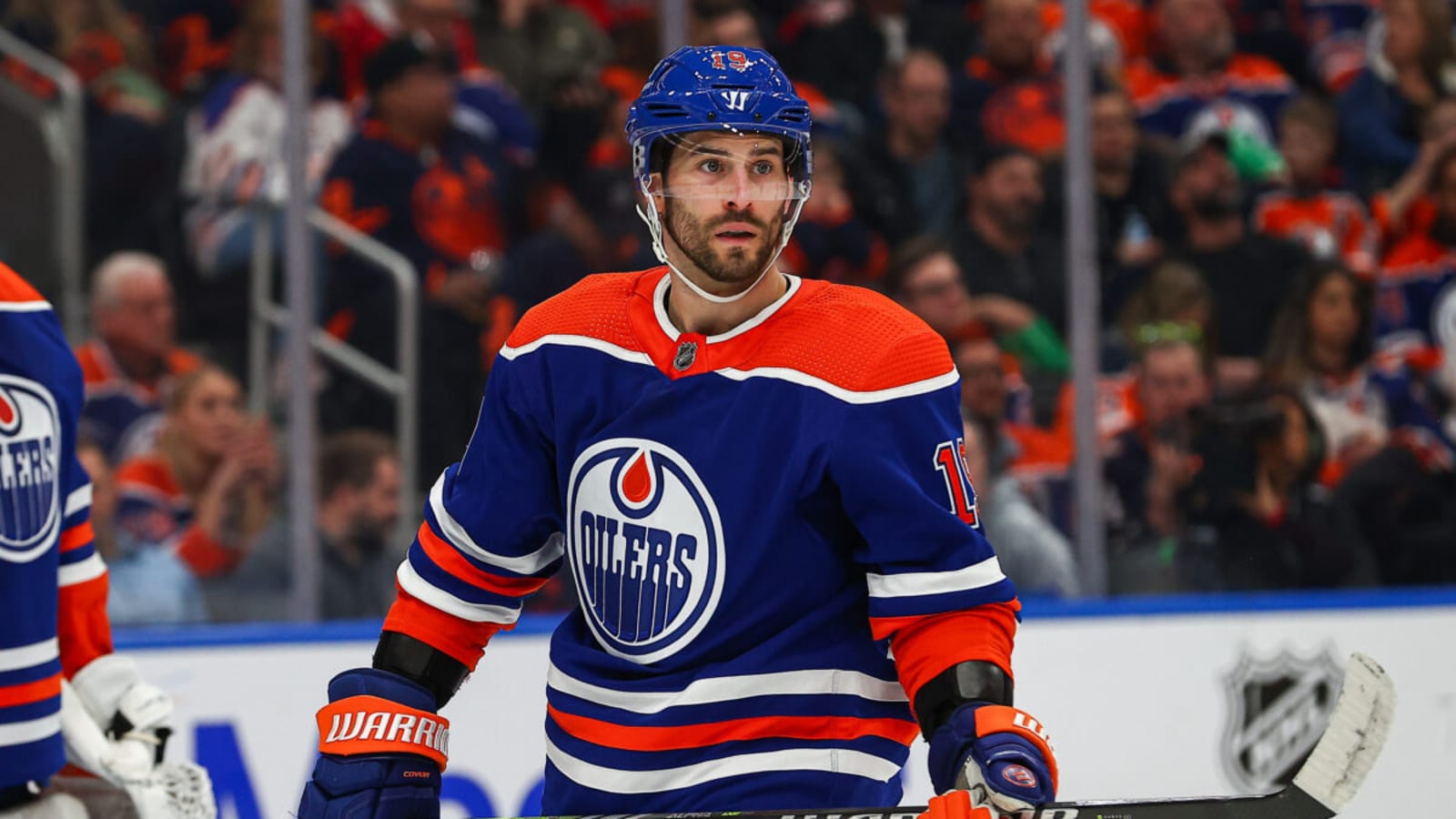
As the 2024-25 Ontario Hockey League (OHL) regular season gets ready to wrap up later this month, it’s a golden time to look back over the last quarter-century of Windsor Spitfires’ action.
The organization has been a hotbed for developing NHL talent for multiple generations. However, since 2000-01, they’ve developed elite talents that have brought them multiple Memorial Cups and brought the community some incredible humans. The NHL and OHL have released several “quarter-century” teams as the 2025 calendar gets into full steam, so what better time to look at the Spitfires’ possible quarter-century team? We’ve managed to narrow it down to just six forwards, four defencemen, and two goaltenders, along with a few honourable mentions that couldn’t be dismissed. From Memorial Cup champions to local icons and much more, these players have made their mark on Windsor, Essex County, and the hockey world. Here are our guesses for the Spitfires’ “Quarter Century” teams.
Quarter Century Team One
Forward Adam Henrique (2006-10)
When you think of the Spitfires’ greats since 2000, Adam Henrique is one of the first players to come to mind. He was a heart-and-soul type that was a big part of the engine that ran the club for four seasons.
He could outsmart you in the offensive zone, scoring 228 points in 238 games, and he excelled at the two-way game. In the 2009 Mastercard Memorial Cup, he also scored the game-winning goal in the semi-final game against the Drummondville Voltigeurs. That sent the Spitfires to the championship where they beat the Kelowna Rockets 4-1 for the organization’s first Memorial Cup title.
Henrique was a fan favourite, a leader on the ice and a leader in the room, and he flourished despite not always being in the direct spotlight. You can’t have a team like this without him.
Forward Taylor Hall (2007-10)
The club’s first-round pick in 2007, second overall, came advertised as a game-changer and eventually became a franchise-changer.
Taylor Hall started his career with 45 goals in 63 games in 2007-08, racked up 106 points in 57 games in 2009-10, and became the franchise force the club envisioned. His resume is stacked with OHL and Canadian Hockey League (CHL) awards, along with two Memorial Cups and multiple Most Valuable Player awards.
Simply put, there isn’t much that Hall didn’t accomplish over his 183 regular season games. He was a beast when they needed him to be, has the third-highest point totals in team history (280), and was a big part of turning the franchise around. The Edmonton Oilers’ first overall pick in 2010 is simply another lock for this team.
Forward Steve Ott (1999-02)
Rounding out the forwards for the first team, we’re going back to the start of the century to get a local fan favourite who embodied what it meant to be a Spitfire.
Steve Ott, born on Prince Edward Island, moved to Stoney Point, just east of Windsor, when he was young. He went through the local hockey system before being drafted by the Spitfires in the second round in 1999. It became one of the best moves the organization had made to date.
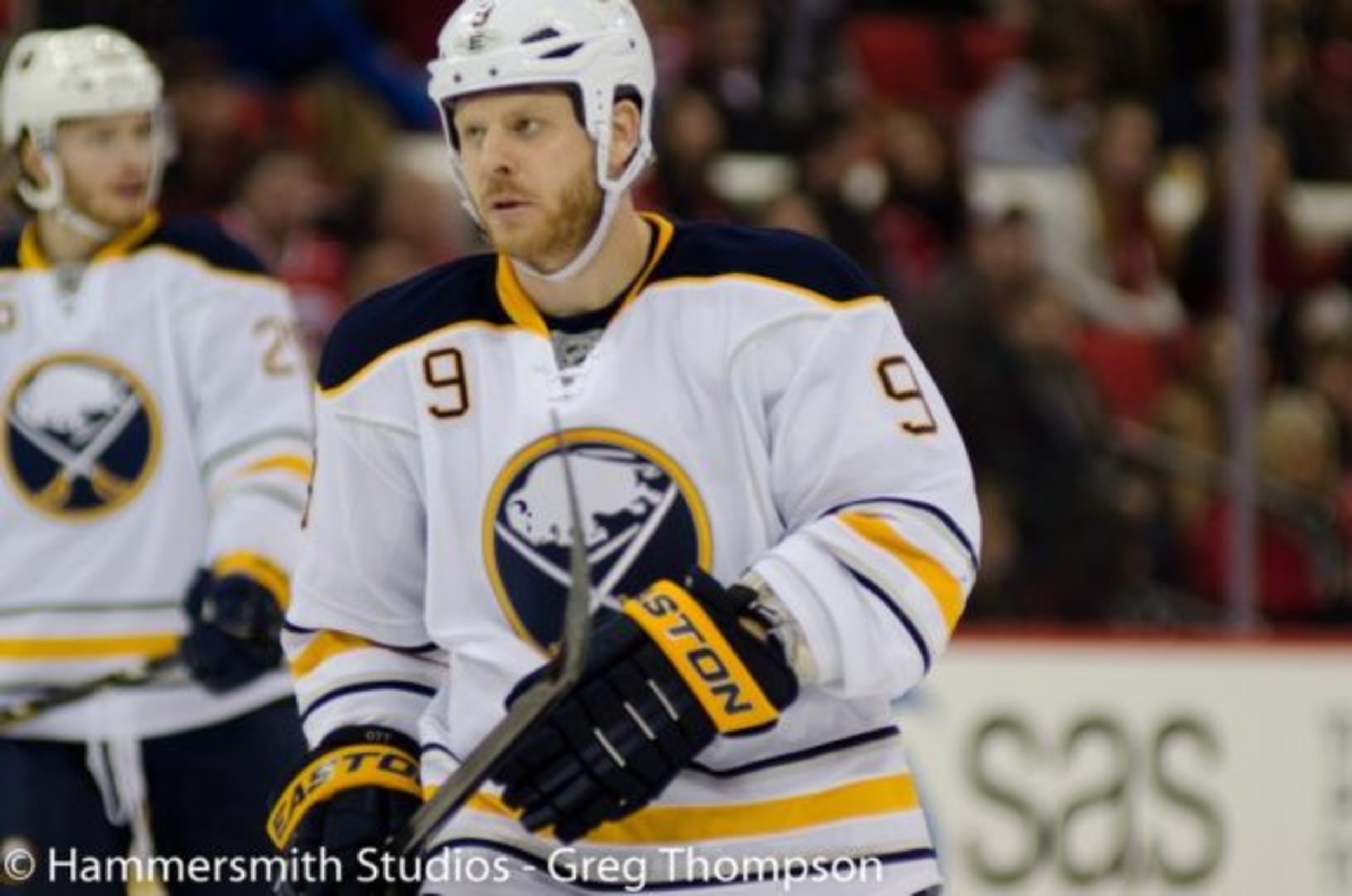
Ott was just 6-foot, 190-pounds but played like a giant. He put up 62 points in 66 games in his rookie season (1999-00) before back-to-back 40-goal, 85-point seasons. That includes the 50-goal mark in 2000-01, where he scored three hat tricks in three games, leading up to needing one goal in his final regular season game. He hit the coveted mark on a penalty shot in that final game, sending the crowd into a frenzy. In 2001-02, he was named captain, adding to his legacy. Add in that Ott wasn’t afraid of anyone and became one of the best agitators in the game, and you’ve got a kid who was born to be a Spitfire.
He was a treat to watch and his number has been retired by the club. This feels like the perfect place for him on this team.
Defence Ryan Ellis (2007-11)
For our defencemen, we’re going back to the Memorial Cup champions in 2009 and 2010 for one of the elite players in the organization’s history.
When the Spitfires drafted the 5-foot-10, 180-pound Ryan Ellis in the second round in 2007, it was tough to imagine what the future would hold. He wasn’t big, but with 93 points and 151 penalty minutes in 75 games in his OHL draft season, it was worth taking a shot. That paid off in spades.
Ellis had 63 points in 63 games in his rookie season, which is impressive for anyone, let alone for a defenceman. He only went up from there, peaking at 100 points in 58 games for the club in 2010-11. He was named captain that season and was the clear choice, taking over for the next player on our list.
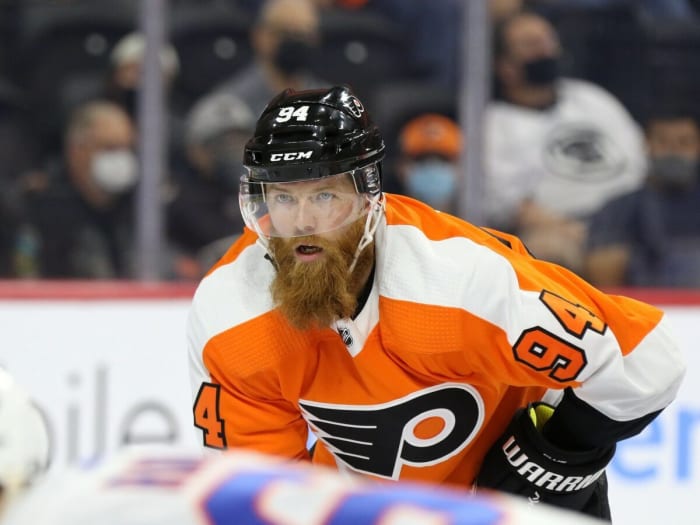
Whether you needed a big goal, a slick pass, a hit, a fight, or just a leader on the ice, there was little Ellis couldn’t do. His resume is similar to Hall’s; he is second on the team all-time in points (314 in 226 games), and his jersey hangs above the WFCU Centre. It would be criminal to leave him off of this team.
Defence Harry Young (2006-10)
We said that Ellis took over the captaincy in 2010-11. He took over for long-time Spitfires’ captain Harry Young, who, similar to Henrique, stayed under the radar a bit.
The 6-foot-4, 225-pound Windsor native came to the club in 2006 after a trade with the Guelph Storm. It became a brilliant move by general manager Warren Rychel. Young wasn’t going to put up a ton of points, and he wound up with just 55 in 277 games. His career high was 20 in 65 games in 2009-10. However, he was that big, stay-at-home player that a championship team needs. Rarely with a smile on his face, he patrolled the blue line with purpose and defended teammates in an instant.
Young was an integral part of the team when then-captain Mickey Renaud suddenly and tragically passed away in February 2008. Following that, Young was named captain to start 2008-09, and he guided them to back-to-back Memorial Cups. He doesn’t come with a long resume, but it’s tough to find a better example of a “Spitfire” than him.
Goaltender Michael DiPietro (2015-18)
When you think of Spitfires’ goaltenders, perhaps all-time, there’s one name that comes to mind instantly – Michael DiPietro.
Rychel drafted the Amherstburg-native in the second round in 2015, but it’s hard to project what a goaltender could do. DiPietro said the right things and had oodles of potential, but production is still needed. He made sure that wasn’t an issue.
The Spitfires went through multiple goaltenders in his rookie season (2015-16), but the youngster forced the club’s hand. He wound up playing in 29 games with a 2.45 goals-against average (GAA) and .912 save percentage (SV%) en route to being an OHL First All-Rookie team member. It only got better from there.
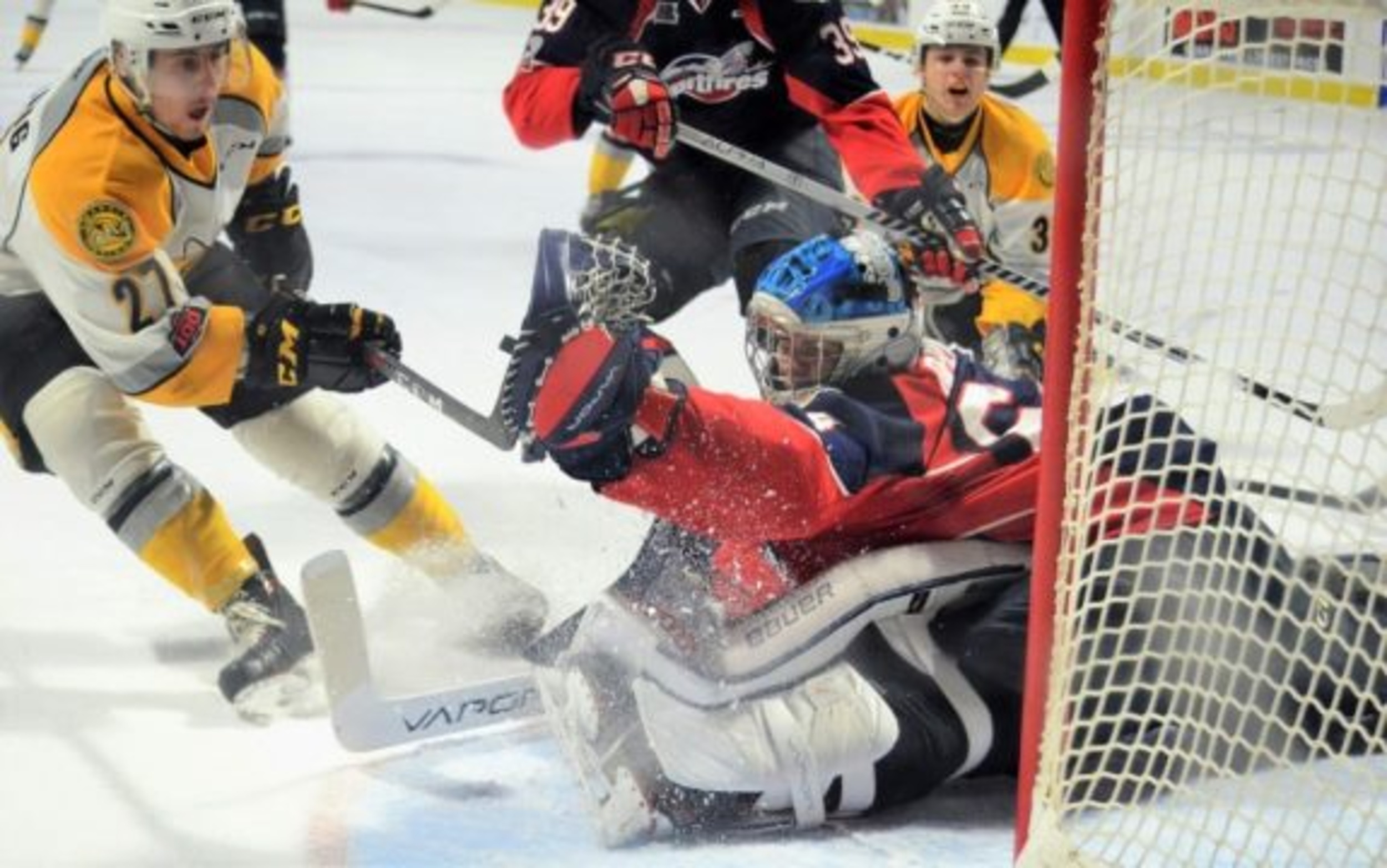
In 2016-17, he got into 51 games with a sparkling 2.35 GAA and .917 SV%. That season, he went 4-0 in the Memorial Cup with a surreal .932 SV%, being named the Memorial Cup’s Most Outstanding Goaltender. He returned the next season, and despite a rebuild, his numbers continued to be elite. Unfortunately, in 2018-19, Rychel made the tough decision to get him another shot at a title. In December 2018, he sent the veteran to the Ottawa 67’s for a significant package of players and picks, thus ending a historic career.
DiPietro set single-season club records, as well as career records, en route to becoming possibly the best goaltender in the team’s history. Every time he took the ice, you knew that you had a solid shot of winning. There’s no other goaltender that can be in this spot.
Quarter Century Team Two
Forward Matthew Maggio (2019-23)
To start our second team, we’re sticking to Windsor and Essex County, specifically a player that Rychel took a shot on, and it paid off in spades.
When Rychel acquired forward Matthew Maggio from the Ottawa 67’s, he saw a kid that had potential, but just needed a chance to show it. The former fifth-rounder only had seven points in 35 games with the 67’s, but there was something to his game. He was quick and shifty, with a solid shot and an even better character. It became a deal that’s still talked about.
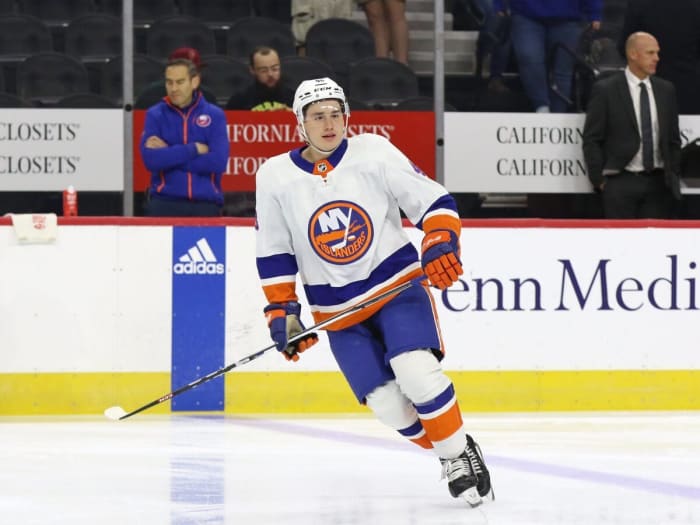
While Maggio had just 14 points in 45 games before COVID-19, he went to Sweden during the pandemic to play for SK Lejon in HockeyEttan in 2020-21. When he came back, he was a new player. In 2021-22, he exploded for 38 goals and 85 points in 66 games. Then, in 2022-23, he had a season that dreams are made of, scoring 54 goals and 111 points in 66 games while being named captain.
From his talent to his off-ice presence, there wasn’t much the guy couldn’t do. His trophy case started to fill up, including a Red Tilson Trophy, and he’s been in the New York Islanders’ system ever since. This was a bullseye acquisition by Rychel and one that deserves to be a part of this.
Forward Aaron Luchuk (2013-17)
Shortly before Maggio arrived, the Spitfires had another complete talent in forward Aaron Luchuk. The Kingston native cut his chops in Junior B before joining the OHL in 2013-14. From there, it was a storybook trajectory, getting better every season. Not only was he a part of the 2016-17 Memorial Cup champions, but he also scored the game-winning goal in the championship game, taking a beautiful pass from Jeremy Bracco in the third period.
Luchuk had back-to-back 25-plus goal seasons with the club and then exploded for 28 goals in 30 games in 2017-18, where he was also named captain. However, that didn’t last long as he was traded to the Barrie Colts in December 2017 as they were going on a run and wanted his leadership abilities. It was an incredibly emotional situation, but he managed to hit the 50-goal mark with the Colts later that season.
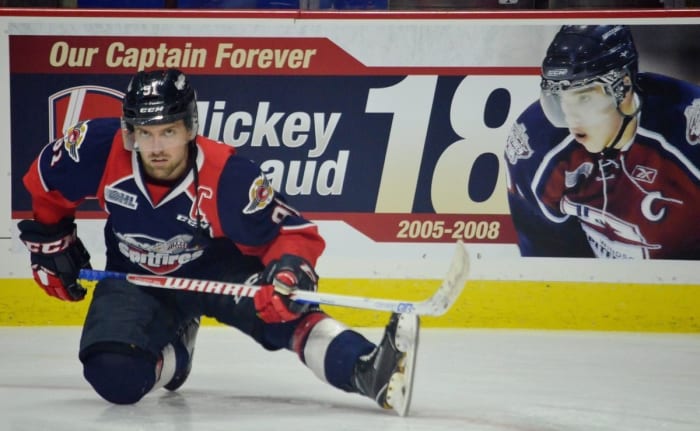
With 187 points in 236 games, as well as being a leader in the room, it’s easy to see why he deserves a spot on this roster.
Forward Craig Kennedy (1999-04)
In the early 2000s, the Spitfires had a line called “M.O.K.”, which was Ott, Shawn Mather, and our latest forward, Craig Kennedy. The 6-foot, 198-pound Sault Ste. Marie native was everything you could want in a player.
The Spitfires’ second-round pick in 1999 was that workhorse that you build teams around. From the start, he was a grinding, two-way forward who could score, hit, and give you plenty of minutes. He only had one season at a point-per-game, when he hit 36 goals and 68 points in 64 games in 2002-03. However, he was consistently around the 20-goal mark with 45-55 points and is third on the club’s all-time games played list with 303, including 258 out of 272 games played from 2000-04.
Kennedy might not have had the publicity of the others, but he gave you everything he had, every night, and was strong as a moose on the ice. They don’t make many like him anymore.
Defence Mike Weber (2003-07)
During Kennedy’s final season (2003-04), a young defenceman named Mike Weber was trying out for the club. The 6-foot-2, 215-pound Pittsburgh native was the Spitfires’ third-round pick and was hoping to get one of the final spots over another rookie. It turned out to be an incredible decision by the organization.
Weber came advertised as a physical defenceman who could defend teammates and his own zone while chipping in offensively. It was mission accomplished. He only put up 10 points in 133 games in his first two seasons, but he learned under veterans like David Bowman, Ian McPhee, and Mitch Maunu, who were all Spitfires’ staples, and bided his time. By 2005-06, he was a seasoned veteran and playing big minutes. He was one of only four players to see action in all 68 games that season, and the only defenceman.
In 2006-07, just after Rychel had bought the team with Bob Boughner and Peter Dobrich, they went into full rebuild mode. While Weber was named captain to start the new era, Rychel had to make the big move. The veteran was sent to the Barrie Colts, who were going for a run (unfortunately, they lost in the second round). It turned out alright, though, as the Spitfires got multiple pieces to help them down the road.
However, Weber’s story with the Spitfires doesn’t end there. In 2017, he joined the team as an assistant coach until COVID-19 hit in 2020. In September 2020, he signed on with the Rochester Americans of the American Hockey League. After his career, he credited former Spitfires’ great D.J. Smith with helping him the most.
The Windsor Spitfires have hired former NHL defenceman and club captain Mike Weber as part of the team’s coaching staff. https://t.co/XGrfLZGYXx pic.twitter.com/h4xW62fVau
— The Windsor Star (@TheWindsorStar) January 31, 2018
Weber went from a possibility to an intelligent, reliable character player and a leader off the ice. He’s certainly deserving of a spot on this roster.
Defence Mikhail Sergachev (2015-17)
Our final defenceman for the second team is a kid that made an immediate impact that will last forever. Nizhnekamsk, Russia native Mikhail Sergachev was the sixth overall pick in the 2015 Canadian Hockey League (CHL) Import Draft.
Each team in the CHL is allowed two Import players (whose parents or guardians reside outside of Canada or the United States). In 2014-15, the Spitfires saw Norwegian forward Markus Soberg graduate but as the club struggled, they knew they would have a top pick in the 2015 Draft. It worked out perfectly.
Sergachev came advertised as a defenceman who was physical, in-your-face, but could put up serious points. He became a star almost immediately with 17 goals and 57 points in 67 games and was named OHL Defenceman of the Year. If you needed a big hit, a big stop, a big goal, or even a teammate defended, the youngster was there to help out.
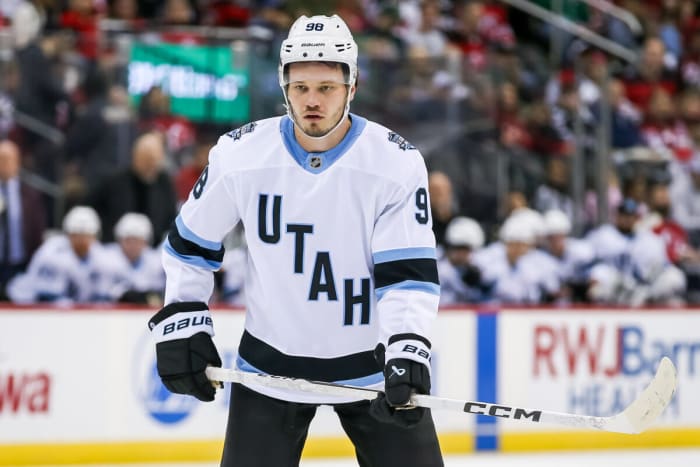
He was drafted by the Montreal Canadians ninth overall in 2016, and there was a worry that he would immediately make the pro club. He actually got four games in before they sent him back to the Spitfires. When he returned, he did his usual by putting up 43 points in 50 games and being a force at both ends.
Shortly after the 2017 Memorial Cup was finished, his rights were traded to the Tampa Bay Lightning and that’s the last the Spitfires saw of him. He was with the Spitfires for just 117 regular season games, but his impact was monstrous. The organization didn’t have an Import defenceman with his impact at both ends until then, and they haven’t had one since. It’s tough to argue this spot going to anyone else.
Goaltender – Andrew Engelage (2006-09)
Our last player on the second team is a goaltender that generally managed to avoid the spotlight. Drafted in the 13th round in 2005, Oshawa native Andrew Engelage started with a season of Junior B before joining a very young, rebuilding Spitfires’ club that went all-in for the youth.
The team traded veteran Anthony Guadagnolo to the Owen Sound Attack early in the 2006-07 season, giving Engelage the keys to the crease. It was a bit of trial-by-fire and he found a way to make it work. While he had a 4.35 GAA, it included a respectable .897 SV%. The talent was there, they just needed experience in front of him. He got that a season later.
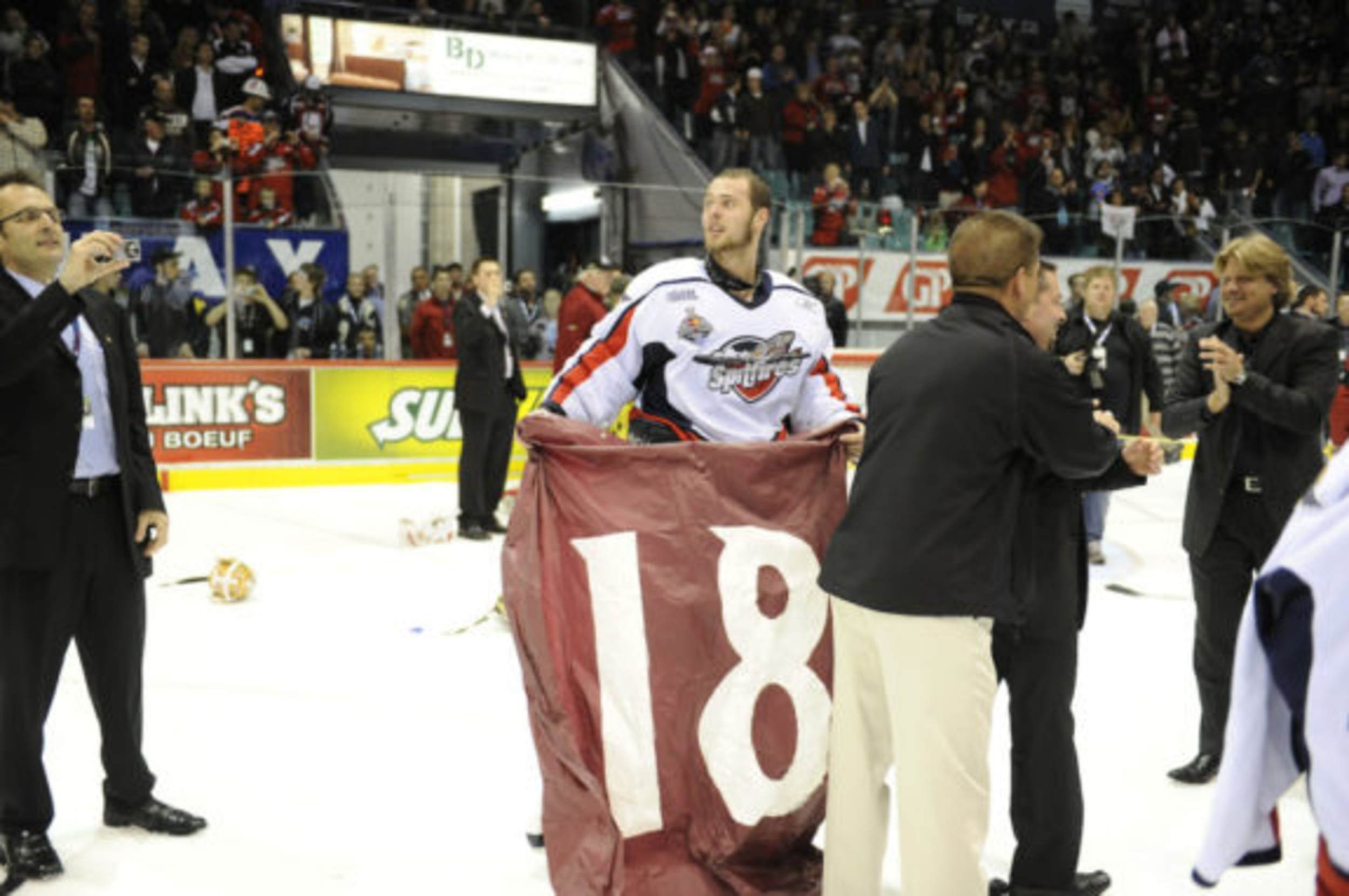
In 2007-08, he shot up to a 2.57 GAA and .908 SV% with a 20-10-8 record. They lost in the first round but it was the experience that gave them another boost. A season later, he returned as an overager (20-year-old) and sported a 2.53 GAA and .914 SV% in a career-high 54 games as they dominated the OHL. He back-stopped them through the playoffs to win the OHL Championship en route to winning the 2009 Mastercard Memorial Cup.
The 6-foot-5, 227-pounder wasn’t the most graceful goaltender, but he always got the job done and shot under the radar on a team that had players like Hall, Ellis, Henrique, and Young. You don’t usually win titles without strong goaltending, and he was an important part of those clubs. That’s why he’s getting a spot on this second team.
Honourable Mentions
As we’ve gone through the Spitfires’ two Quarter Century teams, we feel it’s necessary to give a handful of brief honourable mentions.
Forward Unit – Liam Greentree – Wyatt Johnston – Luke Boka
Up front, we simply couldn’t leave out forwards Liam Greentree, Wyatt Johnston, and Luke Boka. Each one has left a permanent mark on the organization.
Greentree, the current Spitfires’ captain, has been moving up the top-10 list for production and currently sits fifth all-time with 248 points in 187 games. This season, he has an impressive 116 points in 62 games (so far), and we’re eager to see how far he can go.
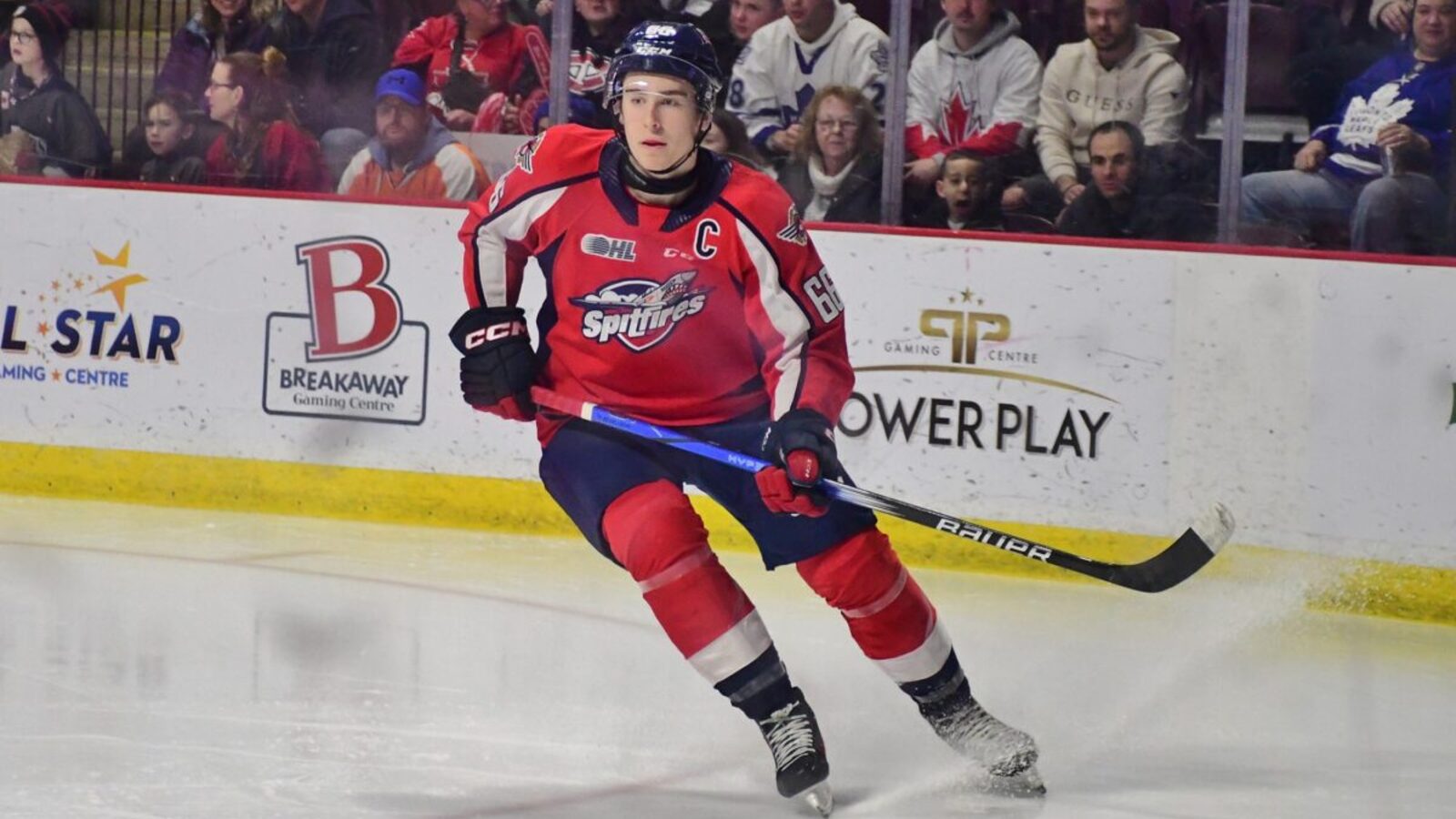
Boka made his mark with the club over several seasons from 2015 to 2020. His 313 games are the most in team history, and despite just 140 points, he was Mr. Everything for the club for a long time. From blocked shots to an incredible two-way game, the two-season captain deserves a spot here, despite having his career end early because of COVID-19.
Johnston was the sixth-overall pick in 2019. He was a Spitfire for just 121 games, but in 2021-22, he dominated with 46 goals and 124 points in 68 games, en route to the Red Tilson Trophy as the OHL’s Most Outstanding Player. His skill, character, and leadership have to be mentioned.
Defence – David Bowman – Patrick Sanvido
For defencemen, we’re going back to the turn of the century. When players like Ott and Kennedy roamed the ice, the Spitfires had Bowman patrolling the blue line. The 5-foot-10, 220-pound St. Catharine’s native was the club’s 20th-round pick in 1999 but had an incredible career. From 2000 to 2004, he missed seven games (265 out of 272 games) and went from 20 points in his rookie season to 43 in 2003-04. He was physical, could stand up for teammates, and was a reliable rock on defence. While he didn’t get the spotlight, he deserves to be mentioned here.
Patrick Sanvido was a giant at 6-foot-6, 231-pounds, but he was a calm, stay-at-home defenceman who relied on his positioning and smarts. He played 250 games for the Spitfires, scoring 36 points, and captained them from 2014 until December 2016, when he was traded to the Sudbury Wolves. The big man was loved on the ice, in the room, and in the community and will forever be a Spitfire.
Goaltending Michael Leighton
Michael Leighton will also forever be associated with the Spitfires. He started in 1998-99 but was a fixture in goal in his final two seasons (1999-01), making 96 appearances with a SV% over .900 and a GAA just under three. He gave the club the reliable goaltending that they had been looking for and was an important piece to rejuvenating the franchise at the turn of the century.
In February 2022, he joined the team as a goaltending coach. However, in November 2023, he resigned shortly after head coach Jerrod Smith was fired. He’s still a regular at the arena, though, and deserves a place in this.
The Quarter-Century Captain – Mickey Renaud (2005-08)
As we discussed earlier, Young took over the club’s captaincy from Renaud, who was a long-time Spitfire forward.
The Spitfires drafted Renaud in the seventh round in 2004, and it was hard to predict what would happen. However, it changed the organization. He was a hard-working forward who could score, use his 6-foot-2, 216-pound frame, and was a leader in the room and the community. The Calgary Flames loved him and drafted him in the fifth round in 2007.
The organization named him captain in 2007-08, and he was the perfect fit. Regardless of age or experience, he welcomed you with open arms and was loved by everyone. However, his story had a tragic ending. On Feb. 18, 2008, he suddenly collapsed at home before a Family Day team event at the Windsor Arena. Despite all efforts, he passed away shortly after. It stunned the organization, community, and hockey world. Doctors determined that he had an undetected case of Hypertrophic Cardiomyopathy, which thickens the heart walls and affects blood flow.
Since then, the organization has done numerous tributes, including retiring his number 18 and building a locker tribute (how his locker looked on the tragic day) in the WFCU Centre concourse. While it’s been over 17 years since that horrible day, his name still comes up on a regular basis. Any Spitfires team that includes players from this era needs to have Renaud on it. He defined what it meant to be a Spitfire, on the ice, in the room, and the community.
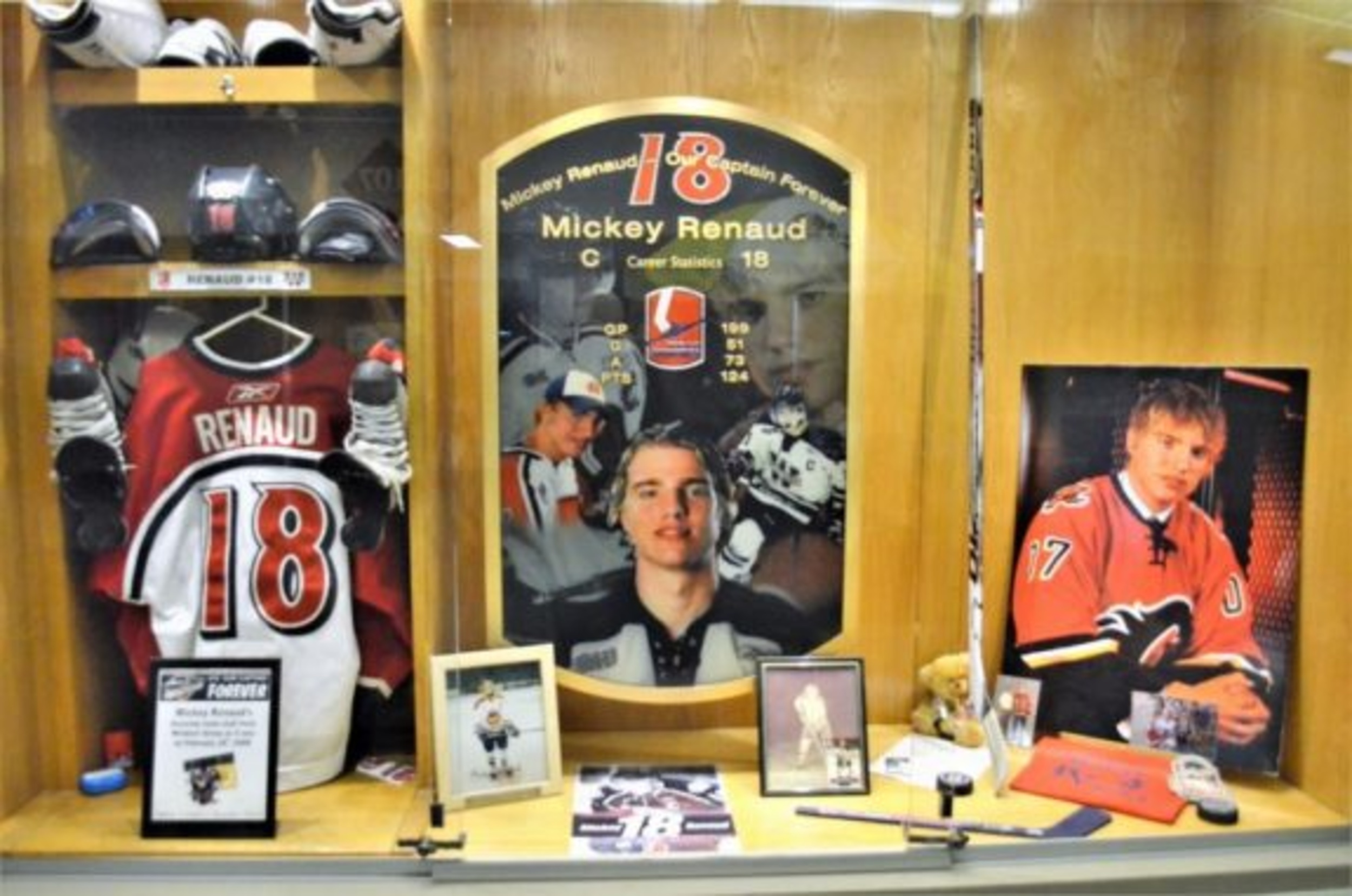
The Spitfires have been a part of the OHL since 1975-76 but the last quarter century has produced some elite talent and humans. There were several players that could be argued for a spot in this, which shows the quality of the organization. We’ll have to see how this prediction fares compared to the one the club releases (if it does).
More must-reads:
- Rickard Rakell undergoes surgery, to miss six to eight weeks
- The best under-the-radar NFL rookies through Week 8
- The 'Active NFL receptions leaders' quiz
Breaking News
Trending News
Customize Your Newsletter
 +
+
Get the latest news and rumors, customized to your favorite sports and teams. Emailed daily. Always free!








